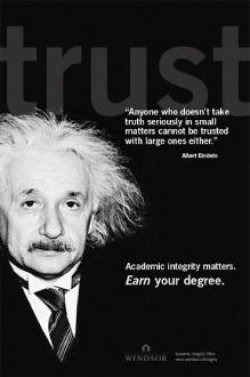OVERVIEW

Poster Credit: The University of Windsor – Academic Integrity Office
While plagiarism may be “an ancient art” (as Stephen Moss put it in a 2005 article in The Guardian), the advent of the internet ushered in many new and frighteningly easy ways for students to plagiarize papers, from purchasing papers from online clearinghouses to pasting together bits and pieces of information (unquoted and uncited) from a variety of internet sources. Luckily, new technologies have also provided teachers with tools for preventing and/or detecting plagiarism.
This page provides resources for helping your students understand and avoid plagiarism, as well as resources for using plagiarism tools.
Also see: Resources for Writers: Academic Integrity for student resources related to academic integrity.
HELPING STUDENTS UNDERSTAND AND AVOID PLAGIARISM
Academic Integrity Tutorial (York University)
A tutorial that explains and demonstrates the issues involved in academic integrity. The tutorial provides case studies and a handy academic integrity checklist.
Avoiding Plagiarism (Purdue OWL)
“There are few intellectual offenses more serious than plagiarism in academic and professional contexts. This resource offers advice on how to avoid plagiarism in your work.”
Deterring Plagiarism: Some Strategies (University of Toronto Writing)
“Knowing how to build personal ideas on past knowledge is a central goal of university study, but it sometimes seems that students hear about it mainly through warnings and threats. Here are some practical ways to lessen the risk of plagiarism in your classes while using writing as a way for students to explore ideas and learn ways of thinking.”
Guidelines for Fair Use (Purdue OWL)
“This handout provides a few general guidelines about fair use policies and copyright laws but no concrete legal advice. Anyone dealing with a specific legal issue or dilemma should contact a lawyer. Anyone making decisions about using multimedia in a class project should first consult the usage policy of their school or institution. The US Copyright Act contains relevant but complex sections that can inform teachers and students making a decision.”
How to Recognize Plagiarism (Elizabeth Boling and Theodore Frick, Indiana University Bloomington School of Education)
A tutorial that first covers when and how to give credit, then offers some examples of real plagiarism cases. This is followed by some examples of cut-and-paste plagiarism and improper paraphrasing. The tutorial ends with a 10-question activity on identifying plagiarism.
Montclair State University Academic Dishonesty Policy (Montclair State University)
An excerpt from the University Code of Conduct that explains Montclair State’s academic dishonesty policy.
Montclair State University Academic Integrity and Plagiarism: A Student Guide(Montclair State University First-Year Writing Program)
Includes the First-Year Writing Program’s Plagiarism Policy, resources to help you avoid plagiarism, and information on documentation.
Plagiarism Prevention Without Fear (online article at Inside Higher Education, Scott Jaschik, January 6, 2010)
Discusses a study that found student plagiarism may be reduced through proper education about “ethical writing practices.”
Season 1, Episode 12: Plagiarism (iTunes U, The Writing Irregulars, Northern Virginia Community College, 14:41 min.)
Podcast by three writing professors at Northern Virginia Community College that discusses the issues surrounding plagiarism that college students face.
Warding off “Virtual Papers” and Ghostwriters (University of Minnesota Center for Writing, Lillian Bridwell-Bowles)
“No system is foolproof if you have determined plagiarists in your classes, but the following are some tips that might thwart the budding thieves whose major crime to date has been procrastination.”
What is Plagiarism? (Rutgers University Paul Robeson Library)
This video is an educational parody of a typical classic 50’s classroom environment. It is part of a 3-part series. Part 1 is “What is Plagiarism?” (2:17) Part 2 is “Plagiarism: Real Life Examples” (2:26) and Part 3 is “The Cite is Right: The Quiz Show” (2:03). There is also a non-interactive video quiz associated with these episodes “Plagiarism Quiz (final part)” (2:56)
Understanding plagiarism
Understand what constitutes plagiarism and how to avoid this serious problem.
USING PLAGIARISM PREVENTION TOOLS
Canvas and Turnitin Integration:
- Using Turnitin in Canvas, Part 1 (HCC eLearning) – Posted on YouTube, October 10, 2011 | length: 3:38 – A brief video that shows instructors how to designate assignments as Turnitin assignments and set their submission guidelines. The video also shows how students submit their assignments and receive a confirmation page.
- Using Turnitin in Canvas, Part 2 (HCC eLearning) – Posted on YouTube, October 10, 2011 | length: 4:55 – A brief video that shows instructors how to view Originality Reports, use the Grademark feature to insert feedback, and grade student writing in Turnitin.
Google – As a teacher, you can usually tell when a student has plagiarized, and often a quick search on Google will, sadly, confirm your suspicions. It’s quite simple–here’s a blog post that shows how to use Google for suspected plagiarism.
How to Find Plagiarism (Jonathan Bailey, PlagiarismToday)
- Copyscape: “A great tool for quick plagiarism searches.”
- Plagium: “A Copyscape alternative that is free and based on Yahoo!”
- Google Alerts: “A free service that can automate basic plagiarism checks and email you results.”
- Tineye: “A visual search engine that looks for copies of an image.”
- FeedBurner: “Offers feed modification and analysis tools that can make detecting RSS scraping much easier.”
TurnItIn
“Used by over 1.6 million instructors at more than 10,000 institutions in 135 countries, Turnitin is the world’s leading cloud-based software for evaluating student work.” Its features include an Originality Report that determines plagiarism, Grademark for providing feedback, and peer review resources.
SafeAssign by Blackboard
“SafeAssign™ is a plagiarism prevention service, offered by Blackboard to its Blackboard Learning System Enterprise, Vista Enterprise and CE Enterprise clients. This service helps educators prevent plagiarism by detecting unoriginal content in student papers. In addition to acting as a plagiarism deterrent, it also has features designed to aid in educating students about plagiarism and importance of proper attribution of any borrowed content.”
